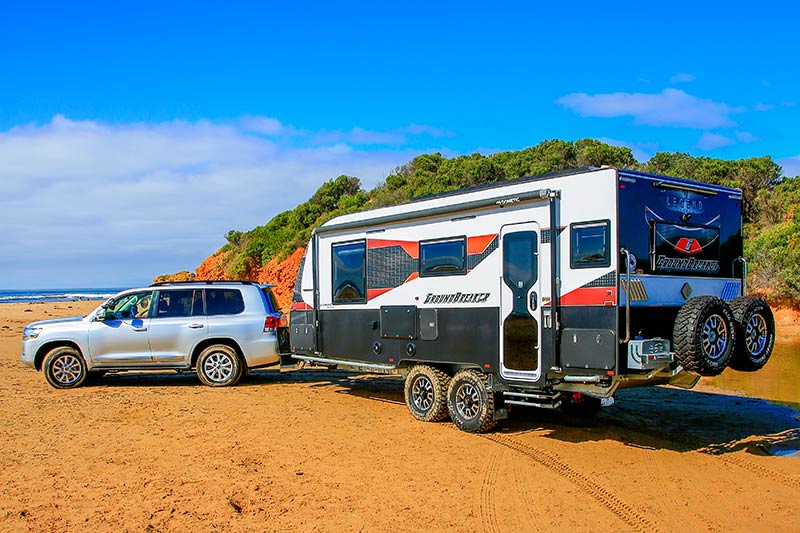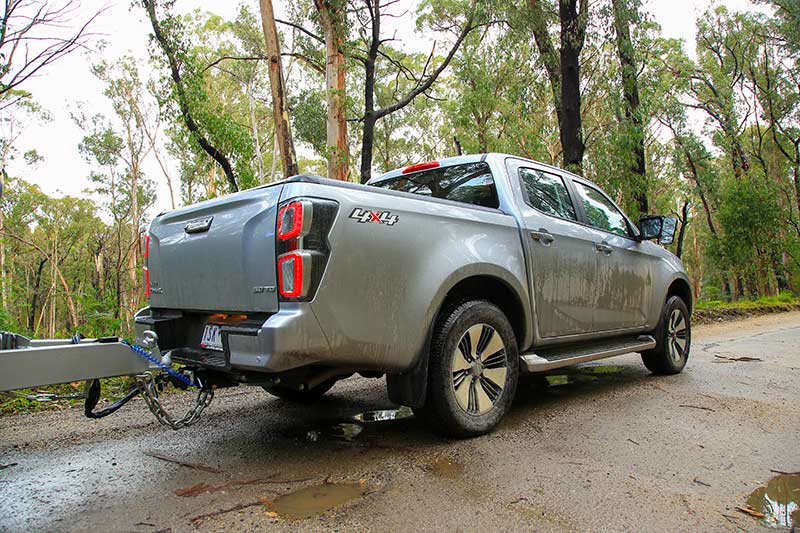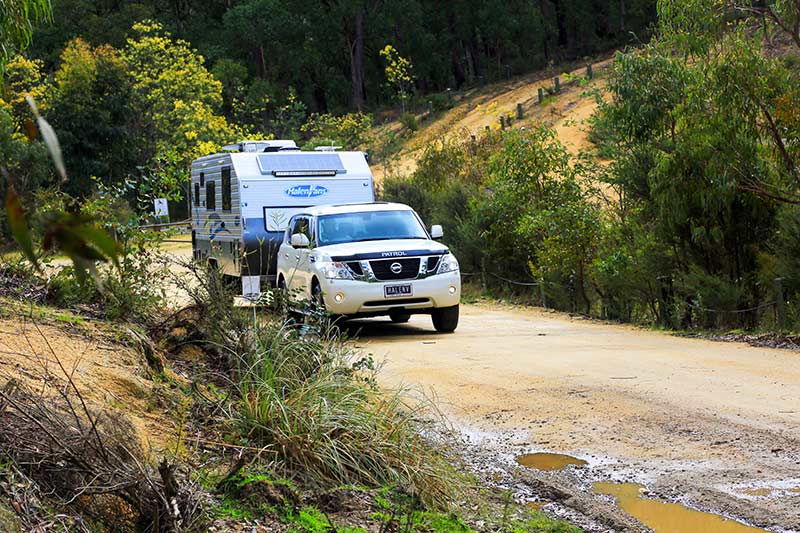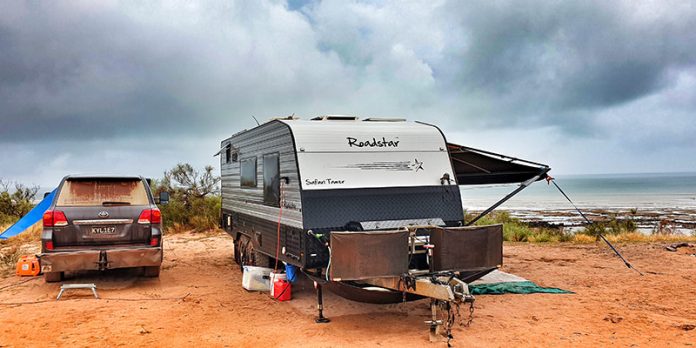Caravanning is not as complicated as you might think. At least, that’s what I wanted to write about. But as I began to write, and as the issues all caravanners who care about safety and the law face began to circle in my brain, I realised that such an article would be a disservice.
The reality is, caravanning can be complicated, particularly when attempting to tow bang-on the legal towing limit of the tow vehicle.
Ultimately, caravanning is supposed to be enjoyable. But that joy will quickly turn to horror if you don’t avoid the pitfall I am going to attempt to explain.
This pitfall perhaps starts with temptation, falling in love with a particular van and signing on the bottom line without adequately understanding the legal capabilities of the tow vehicle. When it comes to towing, the tow tug is inarguably the more important vehicle of the two. Its towing capacities mandate everything, from the weight of the van and therefore its size (usually), to the types of terrain it will confidently tackle.
But before going any further, we need to come to grips with a few key terms, many of which you’re familiar with, but bear with me. This is important.
ATM: This stands for Aggregate Trailer Mass. It is the maximum amount that a caravan can weigh when it is fully loaded for a holiday. It includes any water in the tanks, including grey water, the gas in the cylinders, the food in the fridge, and the dunny rolls in the bathroom. It also includes the weight supported by the jockey wheel or the vehicle towbar when hitched up.
GTM: Gross Trailer Mass. This is the maximum weight that can be transmitted to the ground by the caravan when it is fully loaded. Picture a van on a weighbridge, hitched up so that it’s only the van’s tyres on the scale.
GVM: Gross Vehicle Mass. This term applies to the tow vehicle (or a motorhome). It is the maximum amount that the vehicle can weigh when it’s loaded.
GCM: Gross Combined Mass. This is the maximum allowable combined weight of both the tow vehicle and the caravan.
With this in mind, let’s look at the weights and ratings of three different vehicles: a 3500kg ATM tandem-axle caravan, the 2022 D-MAX LS-U+ ute, and a 2021 Land Cruiser 200 Series GXL, in an effort to demonstrate why it’s so important to properly understand tow vehicle ratings and therefore avoid the aforementioned trap.
2016 200 SERIES CRUISER GXL
Towing capacity: 3500kg
Towball maximum: 350kg
Kerb weight: 2740kg
GVM: 3350kg
GCM: 6850kg
At first glance, the above figures look pretty good! The 200 Series is, after all, a terrific vehicle and an awesome tow tug. So what’s the problem? Well, when hitched to a van loaded up to 3500kg (which includes the van’s loaded ball weight), in-vehicle payload becomes virtually unworkable.

The key to understanding why is to realise that once hitched up, the caravan’s ball weight doesn’t magically disappear. It must be accounted for in your calculations. Rather than being supported by the jockey wheel, it’s now supported by the towbar. In our example, 350kg has been transferred to the vehicle and it must be considered as in-vehicle payload. Therefore, we have to include it in our GVM calculations.
When we do, the results are a little shocking: the venerable 200 Series is left with a measly 260kg of allowable payload capacity to account for passengers, luggage, and any aftermarket accessories, such as a winch and roof rack.
The best way to calculate the available in-vehicle payload when hitched up is to assess it against both the vehicle’s GVM and its GCM.
Against GVM: Remaining in-vehicle cargo capacity is calculated as GVM minus the kerb weight of the vehicle, minus the maximum towball weight.
Against GCM: Remaining cargo capacity is GCM minus the kerb weight of the vehicle, minus the towing capacity.
But things are about to get more confusing. You see, you’d think the answer to these two equations would be the same. But they’re not. And that’s the case with most tow vehicles on the market. In the case of the 200 Series, when calculating in-vehicle payload against GVM, we’re left with a disappointing 260kg. But when we calculate it against GCM, we’re left with 610kg.
The brutal reality is, with most vehicles, including the 200 Series, you can’t load up to GVM without exceeding the GCM, and you can’t meet the GCM requirements without exceeding GVM. That leaves the owner with no choice but to adhere to the lower of the two figures.
So, is 260kg enough? Unless your touring solo with only the bare minimum of luggage on board and very few aftermarket accessories, the answer is no.
2022 D-MAX LS-U+
Towing capacity: 3500kg
Towball maximum: 350kg
Kerb weight: 2112kg
GVM: 3100kg
GCM: 6000kg
What happens when we apply these same calculations to another popular tow vehicle: the D-MAX LS-U+?

Again, assuming the van weighs 3500kg fully loaded, its that pesky 350kg of weight now being supported by the towbar that lets us down.
Calculated against GVM, the D-MAX has 638kg of payload capacity. But against GCM, that figure becomes 388kg. Being the lower of the two, that’s the maximum in-vehicle payload capacity of the D-MAX LS-U+ when hitched to precisely 3500kg of van with a 350kg laden ball weight.
Not wonderful, but surprisingly better than the Cruiser, and roughly on par with many of its competitors.
THE REAL WORLD
The above scenarios are obviously worst-case, detailing what happens to in-vehicle payload when towing their maximum allowable weight. They are certainly not the only vehicles with significantly reduced payload capacities when towing 3500kg. The Ford Ranger is another culprit.
Further, none of this means that they are unworthy tow vehicles. In fact, I have a very high opinion of both the D-MAX and the 200 Series. Additionally, it seems unrealistic that you’d tow exactly 3500kg or that the loaded ball weight would be precisely 350kg.
In the real world, you might have a loaded caravan weight of 3200kg in a van that has a 3500kg ATM, which would probably reduce the ball weight to around 320kg.
Alternatively, you might opt for a caravan with an ATM of 2500kg or less and just enjoy the fact that your tow vehicle isn’t operating constantly on the edge of its capacity. It would also mean you weren’t frequently worried that an extra case of beer inside the car would tip your rig into illegal territory.
While some might say that it’s deceptive of vehicle manufactures to advertise a 3500kg towing capacity and 350kg towball maximum without also advertising the repercussions, the police and the courts won’t care about your moral argument. The onus, as always, is on the driver to know the rules and abide by them.
BUT WHY?
While wrapping my mind around some of these issues, I chatted to our roving technical correspondent, Marty Ledwich. A key theme of our conversation was, why would vehicle manufacturers, who no doubt employ truly talented engineers, overlook the payload problem? And of course, we haven’t even touched on another key issue, that of overloading the vehicle’s axles, in particular the rear axle.

The nearest we could figure, it seems these European and Asian vehicle manufactures don’t adequately appreciate Australia’s caravanning culture. In Europe, a you-beaut tandem-axle caravan would weigh in the neighbourhood of 2000kg, or 2500kg fully laden. On those figures, a caravanner towing with a 200 Series would have all the in-vehicle payload they need. In Asia, well, caravanning just isn’t a way of life like it is here.
But on our shores, our caravans can easily tip the scales at 3500kg ATM, while there’s no shortage of vans with an ATM of 4500kg. Why else would Cruisemaster bother to build the DO45?
There is method to this Australian weight ‘madness’, though. The reality is, we aren’t Europe. We don’t have an Autobahn or some other network of perfectly paved highways that will take you to all corners of the country. As Marty said, “Have you seen the state of the Bruce Highway lately?”
In many cases, our caravans are over-engineered for the simple reason that Australia’s conditions demand it – especially if you want to go offroad, which is half the fun of caravanning.
OTHER TRAPS
By now, you might be thinking, “Gee, this caravanning business sounds like a hassle.”
You couldn’t be more wrong. You see, matching a tow vehicle to a caravan is something you’d only have to do once, or whenever you up or downgrade. Once you’re confident in your figures, it’s just a matter of ensuring you don’t exceed them, and enjoying this fantastic lifestyle.
However, in case you weren’t already confused, some vehicle manufacturers apply stipulations to be aware of. The Y62 Patrol is a case in point. On an older model, Nissan required that the vehicle’s owner reduce the GVM depending on the amount of ball weight on the back.
Mitsubishi, meanwhile, requires that you reduce the 300kg towball maximum to 180kg when towing 3000kg or more with the mighty Pajero.
The message is, don’t take anything for granted. Read your vehicle’s handbook, understand its towing and load-carrying capacities, and look for towball and GVM reductions when towing specific weights.
WHAT CAN I DO?
If you were to find yourself in this situation, is there anything you can do? Yes. You could investigate a GVM upgrade of your vehicle, and there are numerous companies in Australia offering this service. Others offer GCM upgrades, too; however, the law here seems thorny and it would be wise to proceed with some caution.
Failing that… the only alternative would be to downsize your caravan, or upgrade to a big American ute. But even then you might run into the same problem. Did you know that with the Dodge Ram 1500 Laramie V6 diesel, you’re left with 385kg of payload when hitched to 3500kg worth of van with a 350kg laden ball weight? For perspective, that’s less than that offered by the aforementioned D-MAX!
But take heart, fellow traveller. With research, you can avoid all of this by drilling down into the specs of your tow vehicle and understanding its weight and towing ratings before buying that new, lovely caravan.






